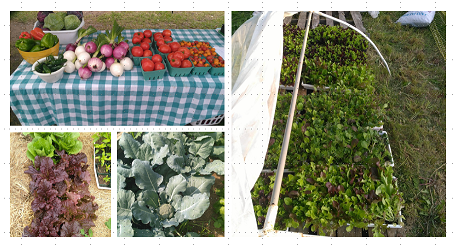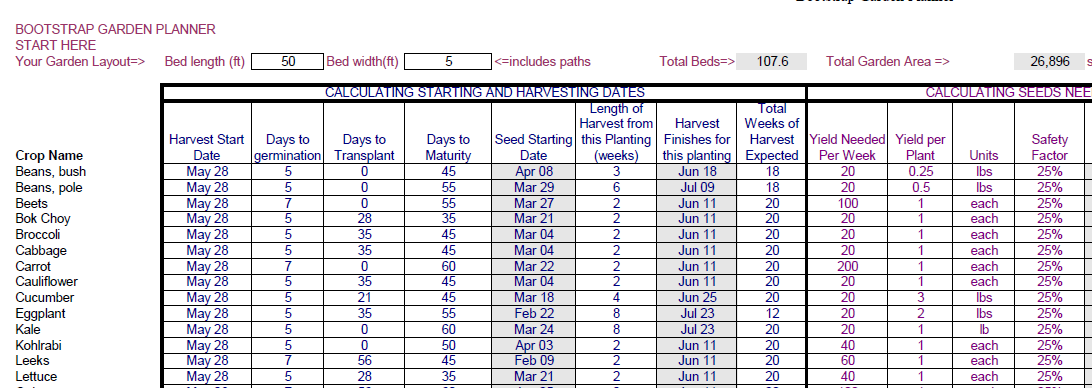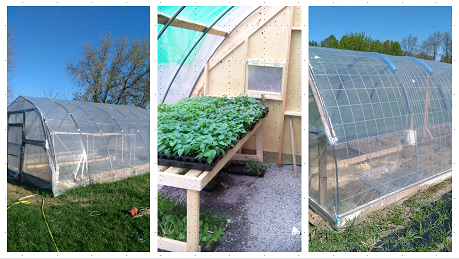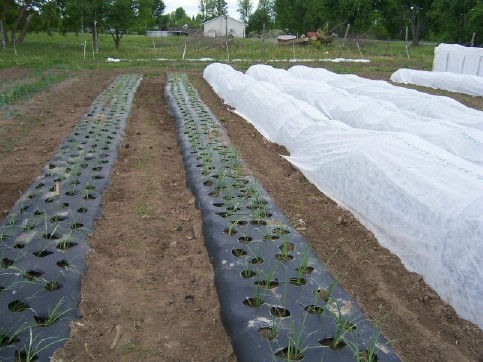Organic Vegetable Garden Tips - The 5 P's
 I love my organic vegetable garden!
I love my organic vegetable garden!Our first project when we started New Terra Farm was a BIG organic vegetable garden. We wanted to know where our food came from and how it was grown.
Our farm home page explains the philosophy we still live by:
Natural is better! Foods grown organically have more of the good stuff (vitamins, minerals and other factors that promote good health) and less of the bad stuff (i.e. herbicides and pesticides) in them.
Over the last couple decades we've learned a few things about growing an organic vegetable garden. Here's some (relatively uncommon) advice to keep in mind.
Grow Your Own Organic Vegetable Garden With These 5 Tips
I call them the 5 P's:
1. Planning is paramount
2. Prevention beats treatment
3. Plastic is your friend
4. Persistence is a must
5. Palatable before popular
Peruse them at your pleasure.
1. Planning is paramount.
If I were to choose one factor that separates the successful gardener from the also-rans, it would be planning.
Here's a typical scenario in my neck of the woods: after a long, dreary winter, the 24th of May weekend rolls around.
This is Victoria Day in Canada, a public holiday, also known as the 'May 2-4' weekend for reasons you might imagine.
All the eager gardeners rush out to the garden supply stores and nurseries, and start buying up all the green things their cars and wallets can bear.
Then they rush home, dig a few holes, and voilà! They have a garden!
Except a few weeks later, the lettuces are done, the broccoli has bugs, and there is STILL not a pepper or tomato in sight. The weeds are thriving, though.
So they give up. There's always next May 2-4, right?
You have to plan your organic vegetable garden in both time and space. You do not need a TARDIS to do this (I use a spreadsheet).
 I grew organic vegetables for 93 families using this planner
I grew organic vegetables for 93 families using this plannerYou need to know and plan for the start dates and maturity dates of your veggies. For example, if I know that my favorite mini-romaine lettuce will mature in 40 days from transplant, I better have more coming if I want to keep eating caesar salad for the summer.
And I better plan for a spot to put them after that first crop matures; it's not a good idea to plant more of the same in the same place (see Prevention).
Another aspect of planning your organic vegetable garden; how much will you eat? Do you want 27 romaine lettuces all maturing the same week, or would you rather 2 or 3 each week over the summer?
You see why it's best to plan this out before you start digging holes. If you have the typical 12-15 crops to manage in your garden, it's hard to keep all that straight without a plan and a schedule.
2. Prevention beats treatment.
By the time the bugs and pathogens have invaded your garden it's already too late. It's harder to control garden pests once they get a head start. Here's how to beat them.
- Good garden nutrition. Start with enriching your organic vegetable garden beds with lots of compost or well-aged manure. Feed the soil so it can feed your plants. Healthy plants are more resistant to pests. See also Crop rotation.
- Good garden sanitation. Clean up garden waste promptly, it's a happy home for bugs and diseases.
- Crop rotation. Plan your garden to ensure crops in the same family are not planted successively in the same space. For example, tomatoes, peppers and eggplant are all in the nightshade family. Find a new spot for them each season. This will help prevent the depletion of soil nutrients and the build-up of pests and diseases.
- Understand pest life cycles. About 10 years ago, an 'old-timer' told me that he never planted his potatoes before July 1. Since then, I have never seen a potato beetle on that late crop. You can't out-breed the bugs but you can outsmart them. Learn when your major pests are likely to appear, and figure out how to thwart them (see Plastic is your friend).
- Practice companion planting. We ALWAYS find room in our garden and our greenhouses for beneficial herbs and flowers. In our big market garden we leave a 'wild strip' right down the middle that grows up with native plants and flowers that attract pollinators and other beneficial insects. Find out which food crops grow well together; e.g. onions and carrots repel each others pests.
See also row cover and plastic mulch below.
3. Plastic is your friend.
I have three greenhouses covered in plastic. They give me about an extra month on each end of my growing season, without requiring supplementary heat. Even a small greenhouse will pay you back many times over for the investment.
 My greenhouse on rails, my lean-to and my 8x12 mini
My greenhouse on rails, my lean-to and my 8x12 miniEliot Coleman (The New Organic Grower) once calculated that growing lettuce locally in a greenhouse consumed 1/20th of the energy required to transport that lettuce in from a warmer clime. This includes the energy embedded in the plastic.
I use row cover (a spun polyester fabric) on many of my crops as protection against both late or early frost and insect pests.
I use plastic film mulches on other crops, to help warm up soil, maintain moisture, and prevent 'splashup' of soil-borne diseases. And earthworms LOVE the extra heat and moisture.
With care, row cover and film mulches are re-usable for several years. And they can be recycled when you're done with them.
 Row cover and plastic mulch in my organic vegetable garden
Row cover and plastic mulch in my organic vegetable garden4. Persistence is a must
This is related to planning. Your organic vegetable garden does not require hard work, but it does require persistent effort. You need to be in that garden a minimum of a couple times a week, and preferably daily to keep on top of things.
That DOES NOT mean you are a slave to your garden. An hour or two a couple times a week, with maybe a extra hour on the weekend to catch up on weeding and planting the next crop, is enough to keep most home vegetable gardens thriving.
I find it best in my big garden to maintain a schedule for activities. I weed on certain days, I water and feed on others. I plan my new plantings and my harvest days. This spreads out the work so you don't get overwhelmed.
5. Palatable before popular.
In other words, grow what you will eat. Your kids will not suddenly develop a taste for kale just because it's in your garden. Grow more carrots and less kohlrabi.
There's another 'P' that applies here as well - Practical. For example, micro-greens are a very popular (and pricey) item in the stores. But unless you are set up for it, they are a pain to grow and and harvest and clean (hint: see the first picture up top, I don't grow my micro-greens in soil).
It takes 5 seconds to pick a pound of tomatoes, 5 minutes to pick a pound of beans, and about 30 minutes to pick and clean a pound of micro-greens (less for me, because I'm set up for it). The home grower should stick to head or leaf lettuce.
Learn the secrets to growing a Bootstrap Survival Garden with this resource from New Terra farm.
Want your own greenhouse but think it's too expensive or too difficult. ? Build your own Bootstrap Greenhouse with this step-by-step guide
Have you thought about making money from your organic vegetable garden? Learn all about garden planning, marketing, management and production right here.
- Home
- Homesteading Today
- organic vegetable garden
Recent Articles
-
Farm grown reviews of products recommended by New Terra Farm
Dec 04, 25 06:26 AM
Find great farm and garden products in my farm grown reviews -
Best Chicken Coop and Accessories for Small Farms and Homesteads
Nov 30, 25 09:18 AM
Looking for the best chicken coop? Here are the top coops, accessories, nest boxes, and gear to build a safe, productive poultry setup. -
Community Supported Agriculture Marketing Ideas To Sell Out The Season
Nov 05, 25 05:18 AM
Authentic Community Supported Agriculture marketing ideas to grow loyalty, boost sign-ups, and sell out your CSA every year



